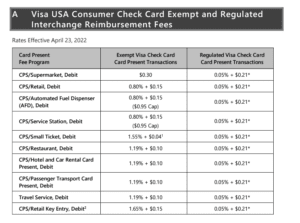Payment processing fees are a significant expense for most businesses. So understanding how and where a transaction is processed makes a difference in the fees a business pays. To learn more about how credit card processing fees impact your margins, see our post “Credit Card Processing Fees and Merchant Margins”
In addition to credit cards, smart business owners also look at their debit card processing. They understand how their business processes debit cards -signature or Pin debit, and how the network the debit transactions are processed on impacts their margins. They also know that other factors like the size of the transaction and the pricing structure of their payment processing company also influence what they pay in processing or transaction fees.
So will take a closer look at the differences between debit card types, their issuers, debit interchange fees, and payment processor pricing structures.
Contents
Signature Debit
For a signature debit transaction, the verification method requires the cardholder to sign a receipt physically, or on a device (terminal) This method is also known as “running the card as credit.” At the same time, it is still a debit transaction.
Running a debit transaction as credit, the sale will get routed through Visa, MasterCard, or Discover’s interchange instead of through a PIN debit network. Since the debit transaction follows the same path as a credit card transaction, the merchant pays the particular card network interchange rate for that type of debit transaction.
Pin Debit
Cardholders must enter their PINs (personal identification numbers) as the verification method for a PIN debit transaction.
For this reason, PIN debit is considered more secure unless the PIN is stolen than Signature debit.
Transaction Flow
PIN debit transactions do not go through a branded card network like credit cards or signature debit transactions pin; therefore, debit networks incur different fees than signature debit sales.
Pin Debit Fees & Durbin Amendment
The Durbin Amendment capped debit fees at 0.05% plus a $0.21 transaction fee for banks with assets of 10 billion dollars or more (regulated). However, banks with less than 10 billion dollars in assets (unregulated) have not had their fees capped.
In response to the Durbin Amendment, card brands created two sets of fees:
- one for regulated card-issuing banks,
- another for unregulated card-issuing banks.
The variation between unregulated and regulated fees can be significant. Here is an example from Visa:

Source: Visa
Their are a variety of Debit networks in the U.S. Merchants can’t control the networks used to process debit transactions, so expect some fee variation between debit networks.
Merchants must also consider their processor’s markup when comparing pin debit and signature debit fees. For a signature debit transaction, your processor will likely apply both percentage-based and per-transaction markups on top of the interchange.
Which is Cheaper, Signature, or PIN Debit?
Signature debit transactions are run cheaper if your business has average tickets under $15. Conversely, a PIN debit card transaction has a lower processing cost if your business average ticket is higher than $15.
Fee Structures and Markups
The difference in costs is due to the fee structure. For example, signature debit card transactions have higher percentage-based fees and lower transaction-based fees. On the other hand, PIN debit transactions have lower percentage-based fees and higher transaction-based fees.
Your processor’s markup also affects the difference in cost. For signature debit card transactions, your processor adds both a percentage and transaction-based fees.
To determine the actual costs you pay for each debit transaction, you need to know your payment processor’s pricing plan – tiered or interchange plus.
Interchange Plus Pricing
For example, let’s look at an interchange plus signature debit card transaction. For example, we’ll assume the card processor charges .015% plus $0.10. Next, add the processor fees to the VISA debit interchange fee to calculate the total fee. As of April 2022, VISA fees were 0.80% plus a $0.15 transaction fee. Therefore, the total fee is 0.95% plus a $0.25 transaction fee.
On a $15 sale, total fees equal $0.385. For a $100 sale, the total fees are: $1.20.
In a PIN debit sale with interchange-plus pricing, let’s assume our processor adds a transaction-based markup of $0.12. If the debit network’s fees are 0.80% plus a $0.185 transaction fee, the total fees for this PIN debit transaction are 0.80% plus a $0.305 transaction fee.
For a $15 sale, the total fee would be $0.425. For a $100 sale, total fees would be $1.11
Tiered Pricing
Let’s assume the average PIN debit network fee of 0.834% plus $0.197 per transaction, and the processor’s PIN debit fee is $0.18. Total fees would be 0.834% plus a $0.377 per transaction fee.
For a $15 sale, total fees equal $0.502, 3% of the total sale. The total fees for a $100 sale are $1.21, or 1% of the total sale.
Conclusion
Understanding which type of debit card is cheaper to process for your business depends on the size of your business and your processor’s markup. Generally, signature debit cards are more affordable to process if your average sale is under $15, and you have interchange-plus pricing with your processor. On the other hand, PIN debit is better for larger tickets and when you have interchange-plus pricing from your payment processor.


